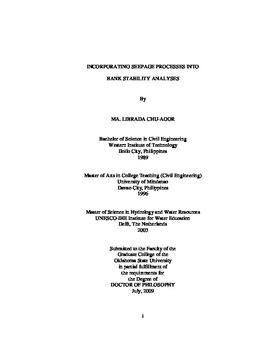| dc.contributor.advisor | Fox, Garey A. | |
| dc.contributor.author | Chu-Agor, Ma. Librada | |
| dc.date.accessioned | 2013-11-26T07:43:13Z | |
| dc.date.available | 2013-11-26T07:43:13Z | |
| dc.date.issued | 2009-07 | |
| dc.identifier.uri | https://hdl.handle.net/11244/6404 | |
| dc.description.abstract | Scope and Method of Study: The overall objectives of this research were to better understand the mechanisms of bank erosion and failure by ground water seepage and to incorporate seepage processes (i.e., seepage erosion undercutting and seepage forces) into bank stability analyses. Seepage processes (i.e., seepage forces and seepage erosion) were not being considered when evaluating the stability of streambanks either for design or investigation purposes. This was due to the complexity of measuring seepage in the field, simulating the processes in the laboratory, and in understanding the failure mechanisms due to seepage. The study was divided into four independent but interrelated sections consisting of laboratory experiments simulating seepage as well as numerical modeling. | |
| dc.description.abstract | Findings and Conclusions: This study showed that streambanks subjected to seepage processes could fail without manifesting prior visible warning when soil strength was exceeded by the combined effects of gravity and seepage forces. Furthermore, streambanks with contrasting soil types and layering under high infiltration may result in soil mobilization and undercutting at the point where water exfiltrates the bank. As the undercut becomes bigger, the bank could fail due to the loss in supporting material. The rate at which seepage erosion occurred (i.e., the eroded mass per time) was predicted in this study using the hydraulic gradient and effective cohesion. The shape of the seepage undercut was represented by a known three-dimensional function which was used to translate the eroded volume into dimensions. The dimensions of the seepage undercut were then used to define the bank profile in a bank stability model. This study demonstrated that seepage processes were important streambank failure mechanisms and in some cases can be more important than the effects of groundwater level. Neglecting these processes in bank stability analyses can result in overestimating the stability of streambanks by as much as 50 to 60%. | |
| dc.format | application/pdf | |
| dc.format | video/x-ms-wmv | |
| dc.language | en_US | |
| dc.rights | Copyright is held by the author who has granted the Oklahoma State University Library the non-exclusive right to share this material in its institutional repository. Contact Digital Library Services at lib-dls@okstate.edu or 405-744-9161 for the permission policy on the use, reproduction or distribution of this material. | |
| dc.title | Incorporating seepage processes into bank stability analyses | |
| dc.contributor.committeeMember | Brown, Glenn O. | |
| dc.contributor.committeeMember | Bulut, Rifat | |
| dc.contributor.committeeMember | Smolen, Michael D. | |
| osu.filename | Thesis-1990D-B595s.pdf | |
| osu.accesstype | Open Access | |
| dc.type.genre | Dissertation | |
| dc.type.material | Text | |
| dc.type.material | Moving Image | |
| dc.subject.keywords | bank stability | |
| dc.subject.keywords | seepage erosion | |
| dc.subject.keywords | seepage processes | |
| thesis.degree.discipline | Biosystems Engineering | |
| thesis.degree.grantor | Oklahoma State University | |
